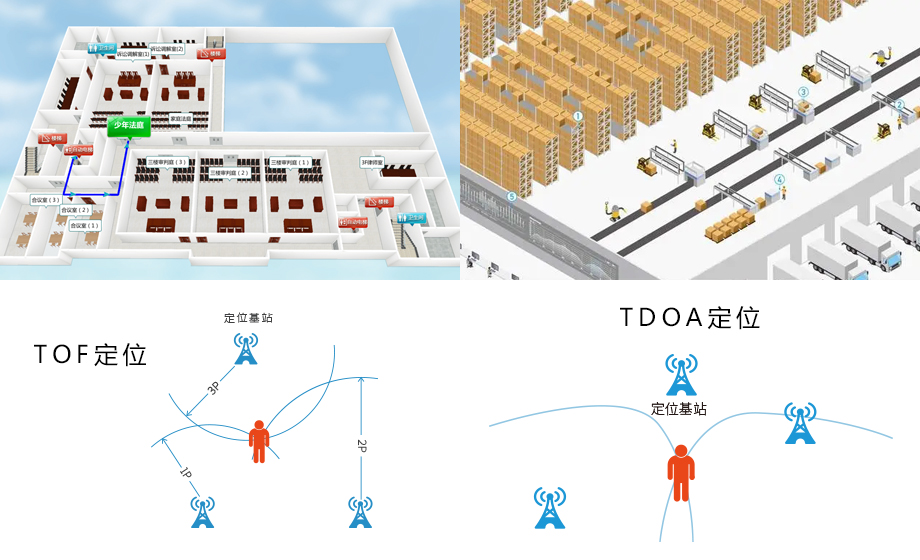uwb ultra-wideband indoor positioning chip positioning TOF/TDOA advantages, with the development and maturity of the Internet of Things technology, all walks of life on assets, materials, personnel and other indoor positioning requirements are increasingly high. UWB positioning system uses non-sinusoidal narrow pulses of nanosecond to microsecond to transmit data and realize positioning, and its positioning accuracy is far from that of other positioning technologies.

Indoor positioning system has successfully combined uwb ultra-wideband indoor positioning chip positioning technology with the Internet of Things, positioning accuracy up to 10cm, achieving UWB positioning system 4.0 in industry, applied in petrochemical, electric power energy, public security and judicial fields.
I. Positioning method of UWB positioning system
1. TOF technology
Timeofflight (TOF) It is a two-way ranging technology, by measuring the flight time between the UWB signal and the tag to calculate the distance. The basic principle is that the base station sends the uwb ultra-wideband indoor positioning chip signal to the observed object (label) continuously, and the label sends the UWB signal to the base station after receiving the signal. Target distance is obtained by measuring UWB signal flight (round trip) time.
2. TDOA technology
TDOA positioning of uwb ultra-wideband indoor positioning chip is hyperbolic positioning, which requires four positioning base stations in two-dimensional positioning. The hyperbola can be plotted by measuring the distance difference between the label and every two base stations, and the label coordinates can be determined by the intersection of the curves. In the process of implementing this method, the label only needs to broadcast the UWB signal once, which is beneficial to the power consumption and concurrency of the label.
2. Advantages of UWB positioning system
1) High precision 10cm
uwb ultra-wideband indoor positioning chip system adopts wideband narrow pulse communication technology (high time resolution, reduce positioning error), multi-source data integration (effectively improve the anti-interference ability of positioning system) and time series signal processing technology (extract the first path signal in the strong multi-path complex environment) to achieve accurate positioning of positioning targets.
2) Wireless synchronization
UWB positioning system uses wireless synchronization technology. By constantly exchanging team clock information with other base stations, each base station finally achieves and maintains overall time coordination. That is, the UWB signal interacts every once in a while, telling the other base stations what time it is, and then adjusting its own time to be in line with the other base stations.
Wireless synchronization depends on the measurement time accuracy of UWB. The higher the time accuracy, the smaller the time error between the two uwb indoor positioning chip base stations, and the higher the degree of time synchronization. The advantage of wireless synchronization is that there is no need for wired connections between base stations, so it is easy to deploy and low cost.
3) Short working time and low power consumption
The UWB positioning system uses intermittent pulse to send data. The pulse duration is very short, generally between 0.20ns~1.5ns, and the system power consumption can be very low. In high-speed communication, the system power consumption is only hundreds of μW~ tens of mW. The power of civilian UWB devices is generally about 1/100 of the power required by traditional mobile phones, and about 1/20 of the power required by Bluetooth devices. As a result, the battery life of UWB devices is a big advantage over traditional wireless devices.
4) Interfere with other devices
Because the uwb ultra-wideband indoor positioning chip has extremely narrow pulse and extremely wide frequency band, its bandwidth is equivalent to 1000 TV channels or 30,000 FM broadcast channels, so the power density per unit bandwidth is quite low. The US FCC severely limits the transmitted power of UWBs, and their power density is even lower than general noise levels (for example, lower than laptop radiation). Therefore, UWB has little impact on other devices.
5) There are many labels that can work at the same time within 1S with high capacity
The UWB positioning system uses bandwidth in excess of 1GHz and even up to several GHz, so the duration of each UWB signal is very short. Generally speaking, signal communication can be regarded as vehicles of different widths, such as bicycles (UWB signal), cars (narrow-band signal), and road width must (time resource). The narrower the vehicle, the more vehicles the road can accommodate. If only bicycles drive on the road and only cars drive on the road, the capacity of bicycles will be much larger than that of cars. Therefore, the uwb ultra wideband indoor positioning chip positioning system has a large capacity and can accommodate hundreds of positioning labels at the same time.



